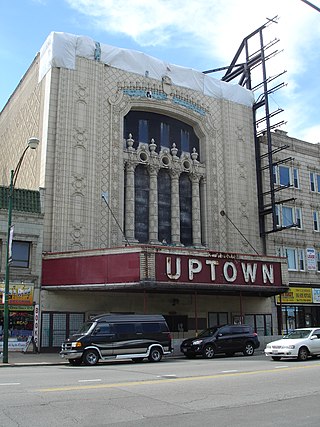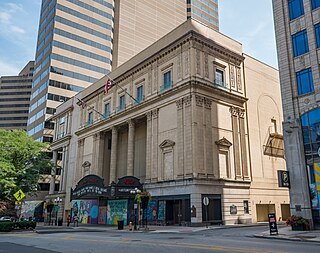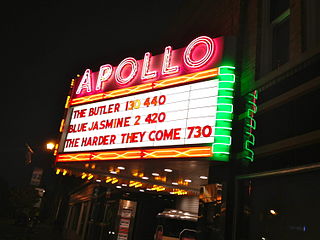
A movie palace is any of the large, elaborately decorated movie theaters built between the 1910s and the 1940s. The late 1920s saw the peak of the movie palace, with hundreds opening every year between 1925 and 1930. With the advent of television, movie attendance dropped, while the rising popularity of large multiplex chains in the 1980s and 1990s signaled the obsolescence of single-screen theaters. Many movie palaces were razed or converted into multiple-screen venues or performing arts centers, though some have undergone restoration and reopened to the public as historic buildings.

The Ohio Theatre is a performing arts center and former movie palace on Capitol Square in Downtown Columbus, Ohio. Known as the "Official Theatre of the State of Ohio", the 1928 building was saved from demolition in 1969 and was later completely restored. The theater was declared a National Historic Landmark in 1977.

The Pellissier Building and adjoining Wiltern Theatre is a 12-story, 155-foot (47 m) Art Deco landmark at the corner of Wilshire Boulevard and Western Avenue in Los Angeles, California. The entire complex is commonly referred to as the Wiltern Center. Clad in a blue-green glazed architectural terra-cotta tile and situated diagonal to the street corner, the complex is considered one of the finest examples of Art Deco architecture in the United States. The Wiltern building is owned privately, and the Wiltern Theatre is operated by Live Nation's Los Angeles division.
The Blue Mouse Theatre title was used for several historic vaudeville and movie venues opened by John Hamrick in the Pacific Northwest of the United States. The name may have been inspired by a lounge in Paris. Hamrick is said to have used the colored rodential title for his first theatre in each city.

The Chicago Theatre, originally known as the Balaban and Katz Chicago Theatre, is a landmark theater located on North State Street in the Loop area of Chicago, Illinois. Built in 1921, the Chicago Theatre was the flagship for the Balaban and Katz (B&K) group of theaters run by A. J. Balaban, his brother Barney Balaban and partner Sam Katz. Along with the other B&K theaters, from 1925 to 1945 the Chicago Theatre was a dominant movie theater enterprise. Currently, Madison Square Garden, Inc. owns and operates the Chicago Theatre as a 3600 seat performing arts venue for stage plays, magic shows, comedy, speeches, sporting events and popular music concerts.

The Apollo Theater Chicago was built in Chicago's Lincoln Park neighborhood in 1978, by theatre producers Jason Brett and Stuart Oken. Located at 2540 N. Lincoln Ave., the Apollo has 430 seats and a lobby featuring art exhibits and a full bar. The theatre is also the home of the Emerald City Theatre Company. The Apollo Theater Chicago has no relation to the Apollo Theater in New York City.
The Center Theatre was a theater located at 1230 Sixth Avenue, the southeast corner of West 49th Street in Rockefeller Center in New York City. Seating 3,500, it was originally designed as a movie palace in 1932 and later achieved fame as a showcase for live musical ice-skating spectacles. It was demolished in 1954, the only building in the original Rockefeller Center complex to have been torn down.

The Paramount Theatre was a 3,664-seat movie palace located at 43rd Street and Broadway on Times Square in Midtown Manhattan, New York City. Opened in 1926, it was a showcase theatre and the New York headquarters of Paramount Pictures. Adolph Zukor, founder of Paramount predecessor Famous Players Film Company, maintained an office in the building until his death in 1976. The Paramount Theatre eventually became a popular live performance venue. The theater was closed in 1964 and its space converted to office and retail use. The tower which housed it, known as the Paramount Building at 1501 Broadway, is in commercial use as an office building and is still home to Paramount Pictures offices.

The James M. Nederlander Theatre is a theater located at 24 West Randolph Street in the Loop area of downtown Chicago, Illinois. Previously known as the Oriental Theatre, it opened in 1926 as a deluxe movie palace and vaudeville venue. Today the Nederlander presents live Broadway theater and is operated by Broadway In Chicago, currently seating 2,253.

The Woods Theatre was a movie palace at the corner of Randolph and Dearborn Streets in the Chicago Loop. It opened in 1918 and was a popular entertainment destination for decades. Originally a venue for live theater, it was later converted to show movies. It closed in 1989 and was demolished in 1990.

An atmospheric theatre is a type of movie palace design which was popular in the late 1920s. Atmospheric theatres were designed and decorated to evoke the feeling of a particular time and place for patrons, through the use of projectors, architectural elements and ornamentation that evoked a sense of being outdoors. This was intended to make the patron a more active participant in the setting.

Located at Six Corners in the Portage Park neighborhood of Chicago's Northwest Side, the Portage Theater is one of the oldest movie houses in Chicago. The Portage Theater opened on December 11, 1920 as the Portage Park Theatre. Built for the Ascher Brothers circuit with 1,938 seats, the Portage was the first theater built specifically for film in the area.

The Broadway Theater District in the Historic Core of Downtown Los Angeles is the first and largest historic theater district listed on the National Register of Historic Places (NRHP). With twelve movie palaces located along a six-block stretch of Broadway, it is the only large concentration of movie palaces left in the United States. The same six-block stretch of Broadway, and an adjacent section of Seventh Street, was also the city's retail hub for the first half of the twentieth century, lined with large and small department stores and specialty stores.
The Boyd Theatre was a 1920s era movie palace in Center City Philadelphia, Pennsylvania. It operated as a movie theater for 74 years, operating under the name Sameric as part of the United Artists theater chain, before closing in 2002. The theater was the last of its kind in downtown Philadelphia, a remnant of an era of theaters and movie palaces that stretched along Market and Chestnut Streets. The Boyd's auditorium was demolished in the Spring of 2015 by its current owner Pearl Properties, which plans to replace it with a 24 story residential tower.

The Orpheum Theatre is a historic theater in downtown Wichita, Kansas, United States. It was designed by renowned theatre architect John Eberson with funding from a group of local investors and opened on September 4, 1922.

The Music Box Theatre is a historic movie theater located in Chicago, Illinois. Built in 1929, it has been operating continuously as an art-house and repertory cinema since the early 1980s.

The Apollo Theatre is a 1913 art-deco moviehouse located in Oberlin, Ohio and maintained by Oberlin College. It is notable as one of the earliest theaters to screen "talkies" and for its use as one of Northeast Ohio's film forums.

Steinway Hall was an 11-story office building, and ground-floor theater, located at 64 East Van Buren Street in Chicago, Illinois. The theater had at least 14 names over the years, opening in 1896 as the Steinway Music Hall, and closing in the late 1960s as Capri Cinema. In the early 1900s, the building held the offices and nucleus of a group of famous Chicago architects that included a young Frank Lloyd Wright. These architects, inspired by the Arts and Crafts Movement and the philosophies of Louis Sullivan, formed what would become known as the Prairie School.

The Hollywood Theater is a historic theater building in Minneapolis which is listed on the U.S. National Register of Historic Places. The Art Deco theater building opened on October 26, 1935, and the marquee proclaimed it the "Incomparable Showcase of the Northwest". The theater, designed by architects Jack Liebenberg and Seeman Kaplan, had a generous budget that allowed for elaborate decoration in the Streamline Deco style of design; its facade and structure made a "powerful statement of geometric mass punctuated by the entrance, exits, and three small windows that served the projection booth." Liebenberg and Kaplan went on to design the Riverview Theatre in Minneapolis and the Terrace Theatre in Robbinsdale. The building featured a tall vertical sign, a patterned terrazzo floor, gilded pillars, and acoustical tiles in geometric patterns. It had a seating capacity of just under 1000. Much of the interior features are influenced by the Zig-Zag Moderne and Streamline Moderne styles. The exterior is built of smooth Kasota limestone with vertical lines that transition to horizontal.

Paris Theatre, formerly Third Avenue Theatre and also known as Paris Theater or Ray's Paris Theatre, is an historic building in Portland, Oregon's Old Town Chinatown neighborhood, in the United States. The theatre was constructed in 1890 and opened as a burlesque house. It was later converted to a cinema, then a club and music venue, before serving as an adult movie theater until 2016. The building was a live venue and nightclub until it closed in October 2019.

















